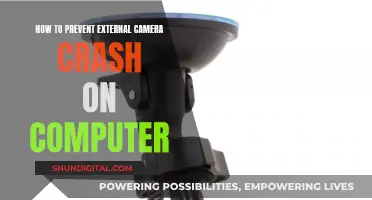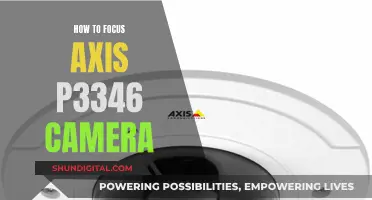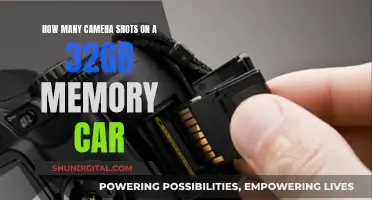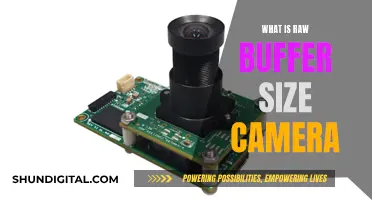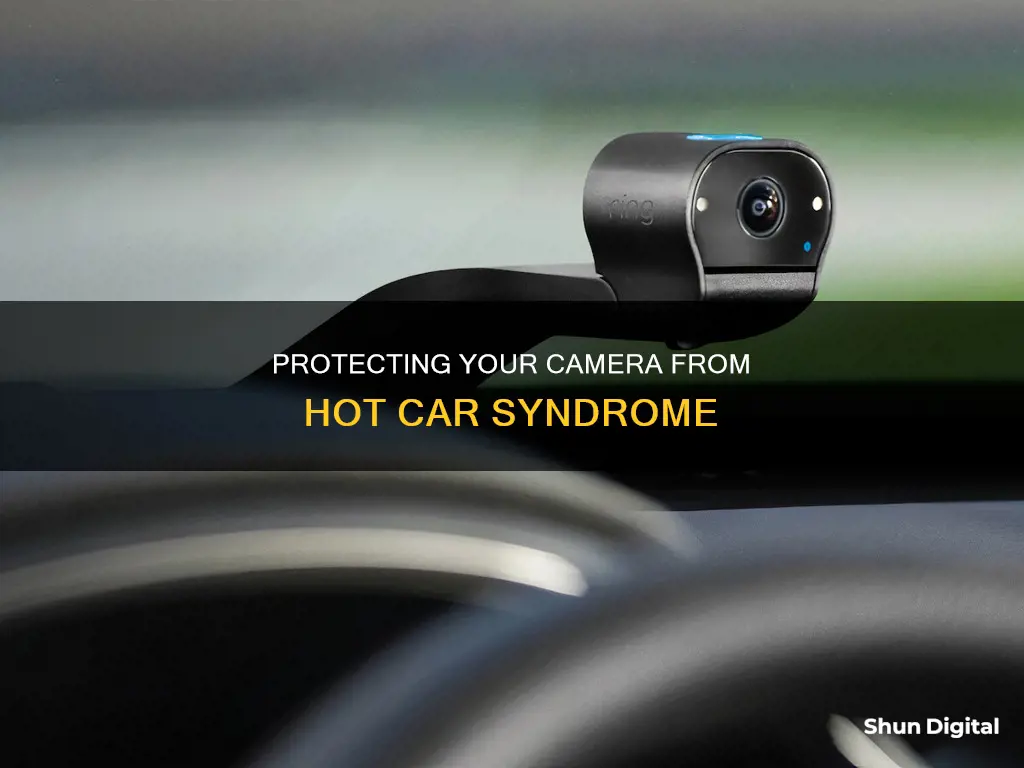
Cameras are sensitive pieces of equipment, and extreme heat can cause serious damage. The inside of a car can get very hot, very quickly, and even a short time in a hot car can cause issues. So, how can you protect your camera in a hot car?
What You'll Learn

Keep the camera in a gear bag with a thick white towel
Keeping your camera in a gear bag with a thick white towel is a great way to protect it from the heat in your car. Here are some tips to maximise the effectiveness of this method:
Firstly, it is important to note that the gear bag and towel are not a substitute for good practices. Avoid leaving your camera in the car if you can. Heat builds up quickly in an enclosed space, even with the windows down. If you must leave your camera in the car, make sure it is only for a short time.
When using the gear bag and towel method, it is best to keep your camera in the bag and drape the white towel over it. This will help to hide your gear from potential thieves as well as protect it from the heat. The white towel reflects heat away from your camera, preventing it from sucking up heat like an all-black camera would. The towel also provides insulation, further protecting your camera from the high temperatures.
If you regularly need to keep your camera in your hot car, consider adding a cooler to your gear bag. Do not add ice, as this can cause condensation, but the closed cooler will provide additional insulation to protect your camera from overheating.
If you are shooting in extreme heat, you can also drape a white hand towel over your camera and secure it with a rubber band. This will provide the same heat-reflecting and insulating benefits as the thick white towel. You can also use a towel to cover your head and body to protect yourself from the sun.
Finally, be mindful of condensation when transitioning between air-conditioned spaces and superheated outdoor environments. Allow your camera to acclimate in your camera bag before exposing it to the open-air heat. This will help prevent moisture from entering your lens, which can shorten its lifespan and allow mould to grow inside.
Traffic Camera Tickets: Enforceable in AZ?
You may want to see also

Add a cooler to your car, but don't add ice
If you regularly need to have your camera in your hot car, consider adding a cooler to the setup. Do not add ice, though! Here are some tips to help you get started:
Pre-Chill Your Cooler
Before placing your camera inside, chill your cooler with ice for a couple of hours or even the day before. This will help cool down the insulation, ensuring that your camera stays at a lower temperature for longer.
Use Ice Packs or Frozen Water Bottles
Instead of regular ice, consider using ice packs or frozen water bottles. These will help maintain a lower temperature without making your cooler and camera gear wet as the ice melts.
Wrap a Towel Around the Cooler
Use a light-coloured wet towel to wrap around the cooler and keep it in a shady spot. As the wind blows over the towel, the water will evaporate, and the towel will become colder, helping to keep the cooler's temperature down.
Keep the Cooler in the Shade
Direct sunlight can heat up your cooler quickly. Keep it out of the sun as much as possible, and if you can't find a shady spot, drape a towel or a tarp over the cooler to protect it from the sun's rays.
Bury the Cooler in the Ground
If you're in a situation where you can dig a hole, such as at the beach or while camping, consider burying your cooler partially underground. The ground acts as a natural insulator, and the deeper you dig, the cooler it will be.
Line the Cooler with Aluminium Foil
Aluminium foil reflects heat and light, so lining your cooler with it can help keep the temperature down. This will prevent heat radiation from penetrating the walls of the cooler and heating up your camera equipment.
Calibrating Camera Focus: The Paper Test
You may want to see also

Turn down power usage
To protect your camera from the heat when it's in your car, you can turn down its power usage. Here are some ways to do that:
- Turn off Live View and use the viewfinder instead.
- Set a short auto-off time so the camera turns off quickly when not in use.
- If you have a flip screen, flip it out to allow heat to escape from the camera body.
- Open the battery door to help dissipate heat.
- If you're shooting video or time-lapse, use a longer mounting plate so you can open the battery compartment while the camera is still mounted on a tripod.
These settings will not only reduce heat but also save battery power.
In addition, you can invest in high-quality cameras with motion detection sensors. These cameras will run in low-power mode until they detect motion and only then start recording. This can save a lot of electricity in the long run.
Polaroid OneStep Close-Up: Battery Life Explained
You may want to see also

Watch for condensation
Condensation is a common issue when moving your camera from a cold environment to a hot and humid one. This can be avoided by allowing your camera to acclimatise to the new temperature. Before exposing your camera to a new environment, place it in your camera bag and close all zippers and compartments. This will allow your camera to adjust to the new temperature without any condensation forming. Depending on the temperature difference, you may need to leave your camera in the bag for several hours.
If you are moving from a cold environment to a hot one, condensation can be avoided by placing your camera in a plastic ziplock bag before taking it out of the cold environment. This will allow the camera to adjust to the new temperature more slowly, and any condensation that forms will appear on the bag rather than on the camera.
If you are in a dry heat area, condensation is less likely to be an issue. However, if you are moving from an air-conditioned space to a superheated outdoor area, condensation may form on your lens. This can be avoided by leaving your camera in your camera bag to acclimatise before exposing it to the outdoor heat.
If condensation has already formed on your camera, do not wipe the lens as this will only cause streaks. Instead, place your camera in an airtight bag and remove as much air as possible. You can also put something in the bag to absorb moisture, such as uncooked rice or a silica gel packet. Wait until the camera comes up to temperature and all condensation has dissipated.
Hardwiring a Dash Camera: A Step-by-Step Guide for Your Car
You may want to see also

Cover your camera with a light-coloured cloth
Covering your camera with a light-coloured cloth is an effective way to protect it from the heat when left in a hot car. This method is recommended by several photographers who are based in hot climates, such as Arizona and the Caribbean.
A light-coloured cloth reflects sunlight and heat away from the camera, preventing the camera from overheating. This is especially important if your camera is black, as these cameras absorb heat more than others. A light-coloured cloth also has the added benefit of hiding your camera from potential thieves.
If you are shooting in extreme heat, you can secure a white hand towel to the camera lens with a rubber band, leaving the front of the lens exposed. You can then drape the rest of the towel over the back of the camera, allowing you to quickly access your controls.
It is also recommended to cover your camera with a light-coloured cloth when it is not in use, whether that is in your car or outside while you are shooting. This will prevent the camera from overheating and protect it from the sun's UV rays, which can cause the exterior finish to fade and certain materials to become weak and brittle.
If you do not have a light-coloured cloth, a white towel can also be used to cover your camera.
Viewing Business Cameras: Comcast's Computer Connection Guide
You may want to see also
Frequently asked questions
No, the majority of cameras are rated for temperatures up to 104°F (40°C). Leaving a camera in a hot car can damage its delicate parts and cause long-term damage.
If you must leave your camera in the car, keep it in a gear bag or a cooler without ice. A large, thick white towel can also help hide your gear from potential thieves and insulate it from the heat.
Use a white hand towel secured to the lens with a rubber band. You can also drape the towel over the camera to cover it and your head to reflect heat.
Yes, turn off the "live view" setting and use the viewfinder instead. Also, set a short auto-off timer so the camera powers down quickly when not in use.
Avoid leaving your camera in direct sunlight or in the car for extended periods. If possible, keep it in the shade or cover it with a light-coloured cloth.



